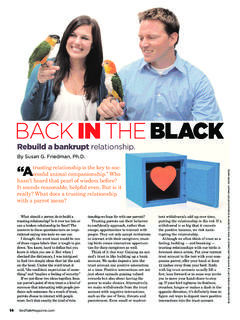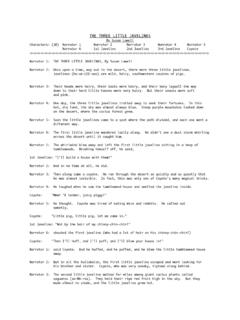Transcription of Behavior Toolkit - BehaviorWorks.org
1 Behavior Toolkit James Fritzler Susan G. Friedman, Ph. D. Teaching new behaviors to learners in your care is not rocket science: It's Behavior science! Anyone can be a successful teacher when they know how Behavior works. Follow the steps and the flowchart below to improve your teaching outcomes. Part 1: Tool Assembly Use the following steps to define the Behavior the learner WILL DO; arrange their environment to make the right Behavior easier; and, identify short-term and long-term reinforcers to teach and maintain the new Behavior .
2 1. Define the Behavior you want the learner to do; this is the target Behavior : What does this Behavior look like? Can you describe it without saying what the Behavior isn't? Without saying "Stop being X" or "Stop [verb]ing"? Can you describe it without using any "labels"? (see List 1). 2. Split the target Behavior into smaller steps to shape: Think of ways the Behavior can be divided into smaller responses to make the Behavior easier to learn. 3. Create a supportive environment before the Behavior occurs: What in the environment has prevented this Behavior in the past?
3 What can you change in the surroundings to make the Behavior easier to do? What cues will signal the learner to do the Behavior ? What prompts will clarify the target Behavior , modeling, verbal instructions, or physical assistance? 4. Identify long-term reinforcers, , the naturally occurring benefits of this Behavior for the learner: What is the natural outcome of this Behavior ? Is it worthwhile enough for the learner to maintain the Behavior in the long run? Consider the different types of reinforcers: tangible items, social interaction, activities, sensory stimulus and escape from aversive events 5.
4 Identify short-term "jump-start" (contrived) reinforcers for teaching this Behavior : What extraordinary reinforcers will initially motivate the learner to do this Behavior ? Are these reinforcers specific and customized to this learner? Can these reinforcers be faded-out as the Behavior is mastered, so that only naturally occurring reinforcers maintain the Behavior ? Examples: praise, edible treats, gentle touch, toy, etc. 2010, JF, SGF. Part 2. Teaching Preparation: Observe and Define Flowchart Behavior Naturally Occurring Reinforcers Environment Jump-Start Reinforcers Throughout the Process: Ensure Naturally Occurring Reinforcers.
5 Deliver well-timed Jump-Start Reinforcers every time the Behavior occurs. Shape the Behavior by reinforcing Arrange environment smaller responses for success. that lead to the final Behavior . Deliver the cue or note the signals that cue the Behavior . No Did the Behavior occur? Yes Emphasize Naturally Occurring Reinforcers. Yes Is a Jump-Start Reinforcer required for every occurrence? Watch for opportunities to No slowly fade out Jump- Start Reinforcers. Maintain environment for mastery and 2010, JF, SGF. transition to Naturally Occurring Reinforcers.
6 List 1. Commonly used labels that don't describe Behavior None of the following words describe Behavior in a functional way. Refer to this list as you describe the Behavior to check if you've used a label. Create your description in terms of what the Behavior looks like. abnormal horrific relentless aggression hyper resent aggressive hyperactive resentful always immodest rowdy angrily impatient rude angry impolite savage antics incorrect shy argumentative indecent silly arrogant infantile slob bashful intention sloppy bossy intentional sly careless intentionally snarky chaotic intentions sneaky cheerful irreverent stern childish irritable strange childlike jealous stubborn clingy kind submissive cocky king tame confused loyal terrible constantly mean territorial controllable
7 Messing testing controlling messy testy crazy micromanage tidy cross micromanaged timid decent micromanaging touchy derogatory modest tough despondent nasty tyrannical dictating neurotic unattached dictator never unbelievable difficult normal uncaring disagree obedient uncontrollable disagreeable odd unfocused disloyal oppressive unhappy disobedient ornery unkind disobey overbearing unlimited disorderly patient unreal disorganized pesky unrealistic distracted polite unrealistic dominate presumptuous unreasonable dominating pretentious unrelenting domineering prince unreliable emotional princess unresponsive emotionally proud unruly emotions psychotic untidy expectation pushy unwilling expectations queen upset expecting questioning vague expects quirky weird funny radical wild grudge rash wildly grudgingly refusal wrong happy refuse wrongly hates refuses








